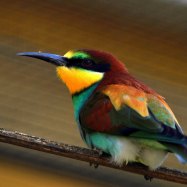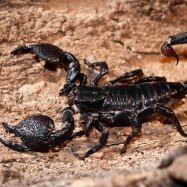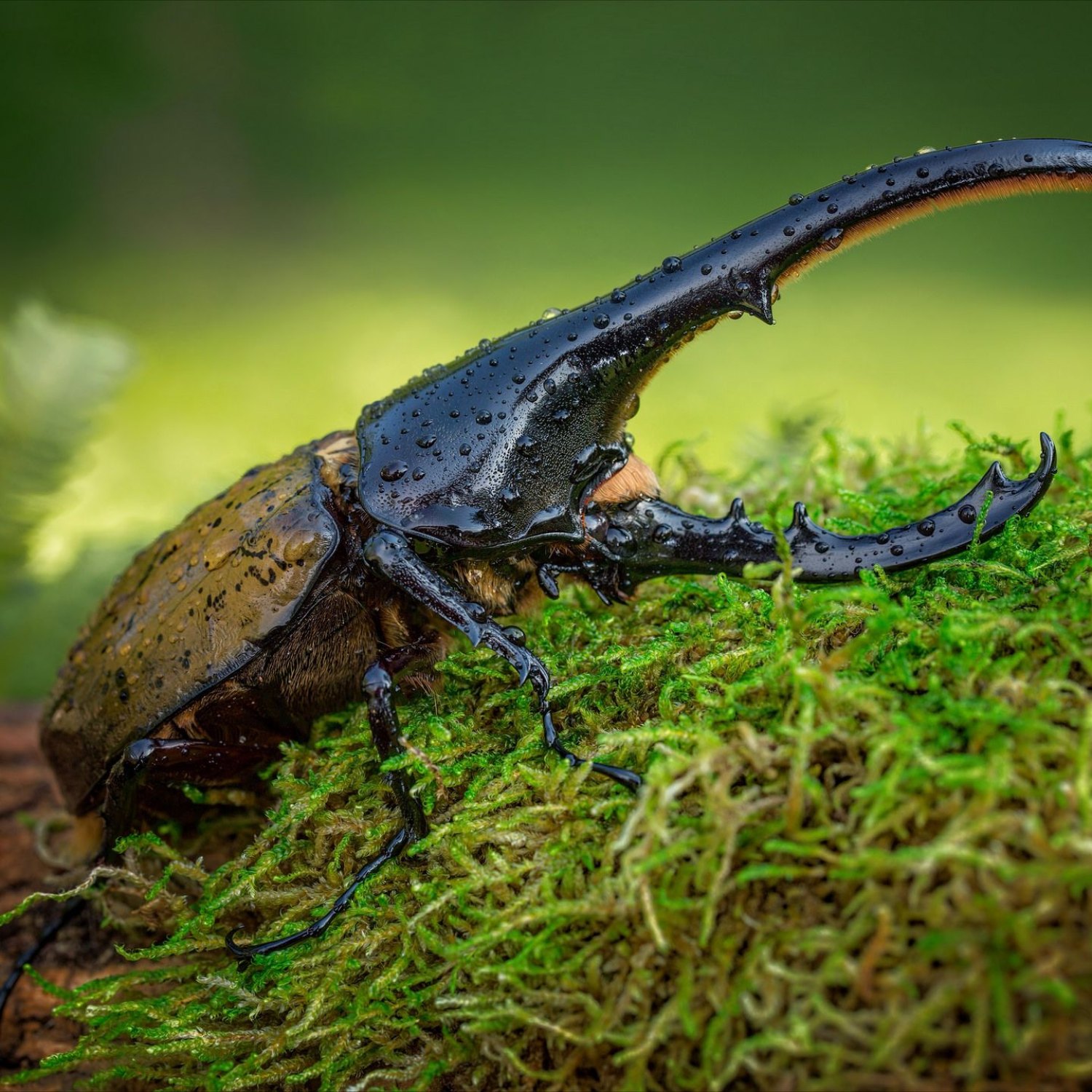
Hercules Beetle
2 to 7 inches
The Hercules Beetle is a remarkable insect found in the rainforests. With a length ranging from 2 to 7 inches and a distinct oval, elongated body shape, this beetle belongs to the Scarabaeidae family. It can be found in the canopy and understory of the rainforest, making it a fascinating and elusive creature to spot. This beetle is known for its incredible strength, able to lift up to 850 times its own body weight. Definitely a must-see for any rainforest adventurer! #HerculesBeetle #RainforestAdventure #Scarabaeidae
Animal Details Summary:
Common Name: Hercules Beetle
Kingdom: Animalia
Habitat: Tropical rainforests
The Mighty Hercules Beetle: A Fascinating Creature in the Tropical Rainforests
Deep within the lush tropical rainforests of Central and South America resides a truly remarkable creature that has captured the imagination of humans for centuries - the Hercules Beetle. This insect, scientifically known as Dynastes hercules, is one of the largest and most powerful beetles on the planet, with an average length of 2 to 7 inches. Its impressive size, coupled with its unique features and behaviors, makes it a truly captivating subject for both animal enthusiasts and scientists alike.Discovering the Kingdom of the Hercules Beetle
The Hercules Beetle, like all living organisms, belongs to a specific taxonomic kingdom Hercules Beetle. According to the data summary, it falls under the Kingdom Animalia, which encompasses all multicellular animals. This classification is essential, as it sets this beetle apart from plants and other non-animal organisms.A Closer Look: Phylum, Class and Order
The Hercules Beetle is then further categorized into Phylum Arthropoda, which consists of animals with jointed limbs and exoskeletons. This classification is fitting, considering that the beetle's elongated body is protected by a hard outer shell. As for its class, it is an insect - specifically, a member of the Coleoptera order. This order is composed of insects with hardened forewings, as seen in the Hercules Beetle's distinctive black, brown, or green elytra or wing casings.Exploring the Scarabaeidae Family
But what truly sets the Hercules Beetle apart from other insects is its family - Scarabaeidae. This family is home to over 30,000 species, including dung beetles and chafers, but the most well-known and iconic member is the scarab beetle. The Hercules Beetle, with its massive size and strength, is undoubtedly the most impressive of them all Hairy Woodpecker.An Insect King of the Rainforests
As its name suggests, the Hercules Beetle is indeed a powerful insect. It has the ability to carry objects up to 850 times its own weight - a feat that is equivalent to a human carrying an elephant! This incredible strength comes from its diet, which is primarily herbivorous. It feeds on fruits, sap, and rotting wood found within the rainforests.The Lush Canopy and Understory as its Home
Speaking of rainforests, the Hercules Beetle is most commonly found in the tropical rainforests of Central and South America. Its geographical distribution includes countries such as Costa Rica, Honduras, Mexico, Nicaragua, Panama, and Venezuela. Within these countries, it can be found inhabiting the canopy and understory layers of the rainforest. These are the two top layers of the rainforest, where most of the plant life and diversity exist.The Majestic Black, Brown, and Green Coloration
One cannot help but admire the sheer magnificence of the Hercules Beetle's coloration. It is mostly black, with hints of brown and green, giving it a majestic appearance. This coloration serves as camouflage, making it blend in with the foliage and bark of the trees within its habitat. This feature is essential for its survival, as it helps the beetle hide from predators.The Distinctive Shape of the Hercules Beetle
Aside from its unique coloration, the Hercules Beetle also possesses a distinct body shape. It has an oval, elongated body, with a rounded head and large jaws. These jaws or mandibles are used for feeding and defending against predators, but they also contribute to the beetle's ominous appearance.Uncovering the Secrets of the Hercules Beetle
Despite being one of the most well-known insects, there is still much to discover about the Hercules Beetle. Scientists have only begun to understand its behavior and lifestyle, and there is still ongoing research aimed at unlocking the secrets of this fascinating creature.The Complex Mating Rituals
One of the most interesting aspects of the Hercules Beetle's life is its complex mating rituals. Male beetles, in pursuit of a mate, engage in fierce and often violent battles with other males. The winner of these battles has the opportunity to court a female by producing loud mating calls using its specialized wings.The Miraculous Life Cycle
The life cycle of the Hercules Beetle is also a fascinating subject of study. From egg to larvae to pupa to adult, it undergoes a remarkable transformation, with each stage presenting unique challenges and adaptations. Eggs are laid in rotting logs or decaying wood, where they hatch into larvae or grubs, known for their impressive appetite and ability to break down wood fibers. After several molting stages, it pupates, and finally emerges as an adult beetle.Conservation of the Mighty Hercules Beetle
With its impressive size and unique features, it's no surprise that the Hercules Beetle has piqued the interest of many people. However, this fascination has also led to its exploitation and population decline. Its habitat, the tropical rainforests, is under constant threat of deforestation, and the beetle's prized elytra is often harvested and sold illegally. This has led to the listing of the Hercules Beetle as a species of concern in some countries and prompted conservation efforts to protect its dwindling population.Efforts to Protect Its Habitat
Various conservation organizations and government agencies have implemented measures to protect the rainforests, where the Hercules Beetle calls home. These efforts include sustainable logging practices, reforestation projects, and conservation areas. These actions not only benefit the beetle but also the entire ecosystem and the indigenous communities living within the rainforests.Combatting Illegal Trade
The illegal trade of the Hercules Beetle's elytra is also being addressed by authorities. With strict penalties and enforcement, many countries have successfully reduced the harvesting and selling of this prized insect. Public education and awareness have also helped in deterring people from participating in this illegal activity.An Inspiration to Humans and Technologies
The Hercules Beetle's significance goes beyond being a fascinating creature in nature. Its remarkable features and behavior have also inspired humans and technologies in various ways.From Jewelry to Robotics
The distinctive and beautiful elytra of the Hercules Beetle, with its iridescent coloration, has been used in jewelry and crafts for centuries. Its strength and endurance have also inspired engineers to develop technologies based on its exoskeleton, such as new types of body armor and robotics. By studying the Hercules Beetle, humans have learned to appreciate its value and adapt some of its characteristics for their own benefit.A Creature to Marvel and Protect
In conclusion, the Hercules Beetle is a creature that truly captivates the mind and inspires the imagination. From its impressive size and strength to its distinct coloration and shape, it's no wonder that it remains a subject of fascination for many. It's essential to continue protecting this majestic insect, not just for its unique characteristics, but also for the important role it plays in maintaining the balance of the rainforest ecosystem. So the next time you catch a glimpse of a Hercules Beetle, take a moment to marvel at its magnificence and appreciate its place in the natural world.

Hercules Beetle
Animal Details Hercules Beetle - Scientific Name: Dynastes hercules
- Category: Animals H
- Scientific Name: Dynastes hercules
- Common Name: Hercules Beetle
- Kingdom: Animalia
- Phylum: Arthropoda
- Class: Insecta
- Order: Coleoptera
- Family: Scarabaeidae
- Habitat: Tropical rainforests
- Feeding Method: Herbivorous
- Geographical Distribution: Central and South America
- Country of Origin: Costa Rica, Honduras, Mexico, Nicaragua, Panama, Venezuela
- Location: Canopy and understory of rainforests
- Animal Coloration: Black, brown, green
- Body Shape: Oval, elongated
- Length: 2 to 7 inches
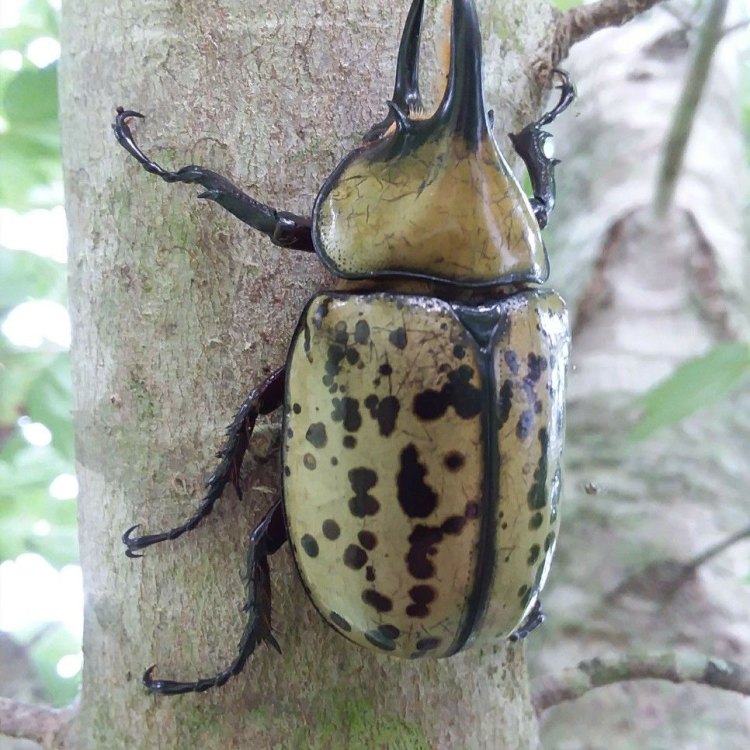
Hercules Beetle
- Adult Size: Up to 7 inches
- Average Lifespan: 3 to 6 months
- Reproduction: Sexual
- Reproductive Behavior: Mating occurs at night
- Sound or Call: None
- Migration Pattern: Non-migratory
- Social Groups: Solitary
- Behavior: Nocturnal
- Threats: Habitat loss, deforestation
- Conservation Status: Not evaluated
- Impact on Ecosystem: Important pollinators and decomposers
- Human Use: Popular as pets and displayed in insect exhibits
- Distinctive Features: Enormous size, long horn-like pincers
- Interesting Facts: The Hercules beetle is one of the largest beetles in the world
- Predator: Birds, small mammals, reptiles
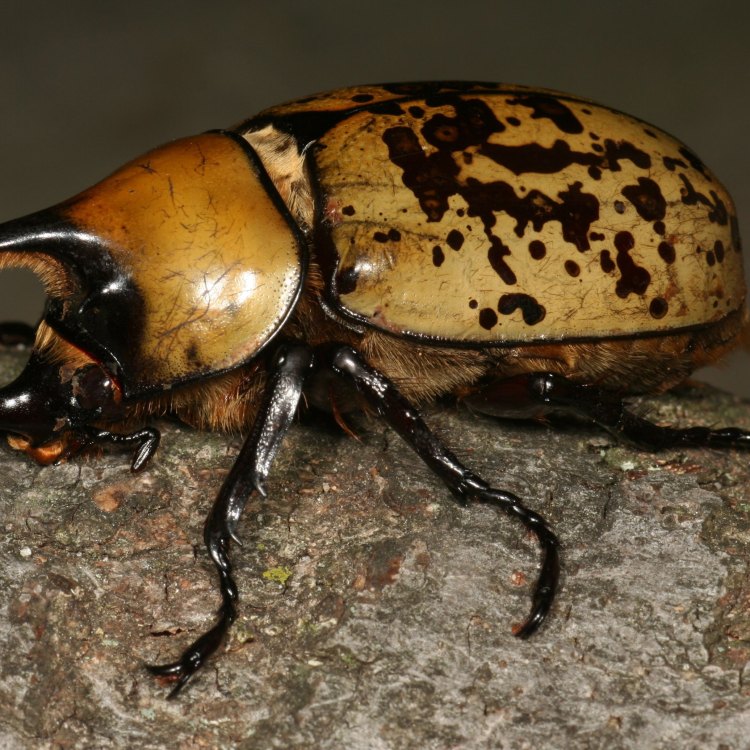
Dynastes hercules
The Mighty Hercules Beetle: A Giant Among Insects
In the world of insects, size is not everything. While some may be small and unassuming, others can tower over their miniature counterparts. One such fascinating creature is the Hercules beetle, a massive insect that can grow up to 7 inches in length. With its distinct features and unique behavior, it captivates the minds of those who encounter it PeaceOfAnimals.Com.The Hercules beetle, also known as Dynastes hercules, is a species of rhinoceros beetle native to the rainforests of Central and South America. It belongs to the family Scarabaeidae, which includes more than 30,000 other beetle species. However, the Hercules beetle stands out among its relatives due to its enormous size and distinctive features.
One of the most striking features of the Hercules beetle is its adult size. At up to 7 inches long, it is one of the largest beetles in the world. To put that into perspective, imagine a beetle that is longer than a standard-sized pencil. Its robust body, oval in shape, is covered in a protective exoskeleton that can vary in color from black to green to brown.
The average lifespan of a Hercules beetle is relatively short, ranging from 3 to 6 months. They begin their life cycle as eggs, which are laid by the female beetle in the soil Hamburg Chicken. The eggs hatch into larvae, known as grubs, which feed on decaying plant matter and other organic materials in the soil. As the larvae grow, they molt several times until they reach their full size. Once they are fully grown, they pupate and transform into adults.
Unlike most insects, the Hercules beetle has a sexual reproduction system. The male beetles have a long, horn-like protrusion on their head, which is used during mating to fight off competition from other males. The females, on the other hand, have two smaller horns on their head. Mating typically occurs at night, with the male aggressively pursuing the female until she agrees to mate. After mating, the female will lay her fertilized eggs, completing the life cycle.
Another interesting fact about the Hercules beetle is its behavior. This massive insect is primarily nocturnal, meaning it is most active during the night. During the day, they can be found resting in the leafy canopy of trees. They are solitary creatures and do not form social groups or colonies like some other insect species. However, during their breeding season, you may occasionally spot them in pairs or competing males. They are relatively calm and docile creatures, but when provoked, they can use their strong pincers to deliver a painful pinch.
One of the distinctive features of the Hercules beetle is its long horn-like pincers. These pincers, located at the front of the male's head, can be up to two inches long. They are used not only for mating but also for fighting off predators and competing males. The male beetle will use its horns to intimidate and push away any threats to its territory or potential mates.
While the Hercules beetle has no known calls or sounds, it does have a unique defense mechanism. When feeling threatened, it can emit a strong odor as a deterrent to predators. The smell is caused by the beetle secreting a liquid from its abdomen, which is then mixed with fecal matter to create a foul scent.
Despite their massive size and strong pincers, the Hercules beetle is still vulnerable to predators. Birds, small mammals, and reptiles are natural enemies of these insects. However, their primary threat comes from humans. Habitat loss and deforestation have significantly impacted their population, making them vulnerable and at risk of extinction.
The Hercules beetle's conservation status is still not evaluated by the International Union for Conservation of Nature (IUCN). However, its role in the ecosystem is critical. As important pollinators, they help in the reproduction of plants and contribute to the health and diversity of their habitat. They are also essential decomposers, helping to break down decaying organic matter and returning nutrients to the soil.
Aside from its ecological role, the Hercules beetle also has some human uses. Due to its impressive size and unique appearance, it has become a popular pet among insect enthusiasts. Some people keep them as pets, while others enjoy displaying them in insect exhibits. They can also be used in education and research to learn more about their behavior and role in the ecosystem.
In conclusion, the Hercules beetle is truly a giant among insects. From its enormous size to its long horn-like pincers, this creature captivates our attention and fascinates us with its unique features. While they may face threats in their natural habitat, their significance in the ecosystem cannot be ignored. As we continue to learn more about these fascinating creatures, let us also strive to protect and conserve their home in the rainforests of Central and South America.

The Mighty Hercules Beetle: A Fascinating Creature in the Tropical Rainforests
Disclaimer: The content provided is for informational purposes only. We cannot guarantee the accuracy of the information on this page 100%. All information provided here may change without prior notice.






